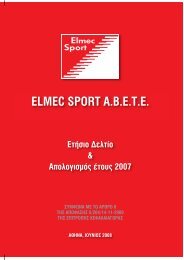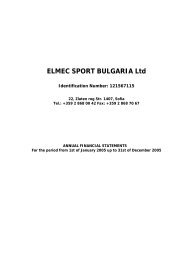ELMEC SPORT BULGARIA EOOD
ELMEC SPORT BULGARIA EOOD
ELMEC SPORT BULGARIA EOOD
- No tags were found...
Create successful ePaper yourself
Turn your PDF publications into a flip-book with our unique Google optimized e-Paper software.
“Elmec Sport Bulgaria” ЕООDReport and Financial Statements for the year ended 31 December 2008____________________________________________________________________The current tax assets for the current and preceding periods are appraised through the sum of money that isexpected to be refunded by the tax authorities in applying tax rates and tax laws that are already in force, or areexpected to take effect by the balance sheet date.InventoriesThe enterprise applies the IAS 2 to account for inventories:Inventories are assets:- held for sale in the ordinary course of the economic activity (goods, products);- being in a process of production for such sale (work in progress);- inventories which are expended in the production process, or at providing services; (raw materials)The inventories are valued under the lower one of either the cost price or the net realised value.The consumption of inventories is valued according to the average weighted price.Assets Held for SaleAs assets held for sale according to the IFRS 5 are classified non-current assets, whose balance sheet value will berefunded through a sale transaction, rather than by ongoing use.The assets held for sale are appraised under the lower one of either their balance sheet value, or their fair value,reduced by the expenses for the sale.Loss due to devaluation is recognised at every initial or subsequent reduction in the value of assets held for sale.Profit due to subsequent increase in fair values, reduced by the expenditure for sale of assets held for sale, isrecognised up to the amount of devaluation of the respective asset, already calculated according to the IAS 36 andIFRS 5.Share CapitalThe share capital consists of:• Registered capital – presented according to its nominal value as per a court judgement for registration• Unpaid capital – it is the non paid-up part of the fixed capital on nominal size.• Bought own shares – presented by the value of what was paid for the reacquisition.Reserves including:• Reserve of subsequent valuations – formed according to the requirements of IFRS and the appliedaccounting policy;• Premium reserves – formed by issue of share capital instruments.• General reserves – formed by the distribution of profit according to the requirements of the CommercialAct of the Republic of Bulgaria and the memorandum of association of the enterprise.• Other reserves – formed by a decision of the capital ownersFinancial result including:Retained profit from previous periods, not distributed by the date of the financial statements.Accumulated loss from previous periods, not covered by the date of the financial statements.Profit or loss for the period.Current and Non-Current LiabilitiesA liability is defined as current, when it meets some of the following criteria:• It is expected to be settled within the normal operating cycle of the enterprise;• It is held mainly with the purpose of trading;• It should be settled within twelve months from the financial statements date;• The enterprise does not have the unconditional right to postpone the liability settlement for a period of atleast twelve months from the financial statements date;A liability is classified as non-current if it does not meet the criteria for definition as current one.A liability is classified as current, when it should be settled within twelve months from the financial statementsdate, even if:• the initial term was for a period longer than twelve months;and• an agreement was concluded after the balance sheet date and before the financial statements have beenapproved for publication, for refunding or for a new repayment plan on a long-term basis.Loans, Trade and Other liabilitiesLoans, Trade and Other Debts, are financial liabilities arising from the direct providing of goods, services, moneyor money equivalents from creditors.After the initial recognition the loans and the trade debts that have no fixed maturity, are accounted for by thevalue estimated at their acquisition.10








